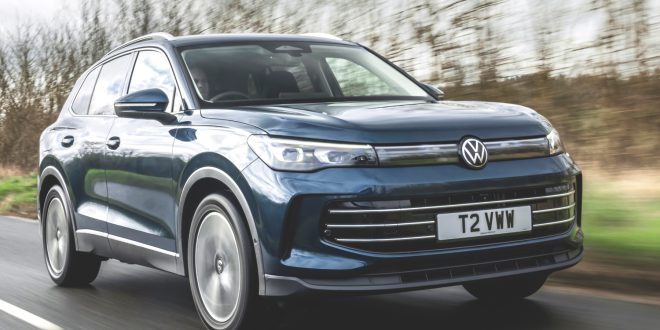We road test the latest version of VW’s biggest selling car – the Tiguan family crossover…
The Tiguan is a hugely important model for Volkswagen. Since the family crossover was first launched back in 2007, nearly eight million have been sold and it’s the German giant’s best-selling car globally.
However, there’s no time to rest on your laurels in the automotive world, so it’s welcome to the third-generation Tiguan.
It’s got its work cut out too, because its many rivals in the mid-size family SUV sector include the Nissan Qashqai, Kia Sportage, Ford Kuga, MINI Countryman and Hyundai Tucson.
On the engine front, Volkswagen has covered most bases with a choice of petrol (TSI), diesel (TDI) and mild-hybrid petrol engines (eTSI) from launch.
Later in 2024 there will be two plug-in hybrid (eHybrid) models offering offer up to 62 miles of electric range thanks to a large 19.7kWh battery.
All Tiguan models now feature automatic transmission, while 4Motion (four-wheel drive) is only available in the more powerful 2.0-litre petrol turbo (TSI) powered cars.
At 4539mm long, 1639mm tall (minus roof rails) and 1842mm wide, the new Tiguan is 30mm longer, 4mm taller and the same width as its popular predecessor.
Looks-wise, it’s fair to say that it’s more of an evolution of the outgoing model, rather than cutting-edge design.
Overall, the styling is smoother and more curvaceous (the drag coefficient has improved from 0.33 to 0.28) and its front end is not unlike its all-electric ID cousins.
At the back, there’s a full-width horizontal LED strip with classy ‘Tiguan’ lettering on the tailgate.
The biggest changes are inside, where the third-gen Tiguan has been treated to a new cabin sporting a cleaner look, improved technology, higher quality materials and more space than its predecessor.
All versions come with a 10.3-inch driver’s digital instrument panel, plus a central 12.9-inch infotainment touchscreen. A huge 15.0-inch version is also available as part of an upgrade – as is a head-up display.
The touch sliders at the bottom of the infotainment screen work better than some of the original ID models and they are now illuminated so easier to use at night. Thankfully, there are physical buttons on the steering wheel, rather than touch-sensitive controls.
There’s plenty of space for all the family, with ample head and legroom for rear passengers, plus a large 648-litre boot.
Overall, the cabin is comfortable and pleasant (if slightly business-like) place to be with good visibility and clear, intuitive instrumentation and solid build quality.
My test car was a 1.5-litre eTSI mild (48V) hybrid, pushing out 148bhp. As you’d expect, the driving position is suitably high, while the gear selector has been moved up to the right-hand side of the steering column, meaning the left stalk now controls the windscreen wipers and indicators.
Mercedes-Benz already does this, and once you get over the initial wiper/indicator activation mistakes, it kind of works, but my preference would always be for separate stalks. Additionally, there are gear-change paddles behind the steering wheel.
It’s also worth noting that Volkswagen has decided to fit a useful rotary controller down in the centre console which adjusts the radio volume and switches between drive modes (Eco, Comfort, Sport or Individual).
For the record, the Tiguan I drove is capable of 130mph with a respectable 0-62mph time of 9.1 seconds. CO2 emissions and economy are a claimed 141g/km and 45.6mpg respectively, with the latter seemingly very achievable even after a few hours of mixed driving.
On the road, the four-cylinder engine is smooth with plenty of mid-range pulling power. It will become more vocal under heavy acceleration, but for the most part it’s impressively refined.
The slick seven-speed DSG automatic gearbox works well, though it occasionally holds onto gears for a fraction too long.
It would be an exaggeration to say that the Tiguan’s ride and handling are class-leading, but they are well up to the job. The suspension is at the firmer end of the scale, but not uncomfortably so. The steering is easy and light, and the car is generally composed with good body control in faster corners, combined with ample grip.
Choose Sport mode and the throttle and gearbox are a tad more responsive, but then performance and dynamism aren’t the main priorities for the family favourite that is the Tiguan.
At launch, the Volkswagen Tiguan range consists of five trim levels (Tiguan, Life, Match, Elegance and R-Line) with prices starting at £34,075.
Verdict: Volkswagen has played it safe with the much-improved third-generation Tiguan, sticking with a winning formula of understated style, comfort and quality. The good news for families is that it now also boasts more space, it’s equipped with the latest technology and safety kit, and it’s more economical.








